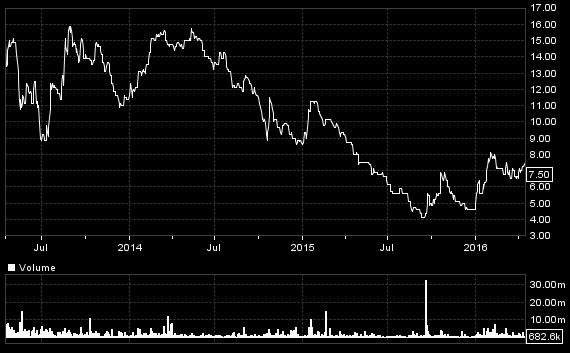Shanta Gold: A Goldie for Steady Growth?

469m shares in issue
Current mid-price: 7.4p
£34.7m market cap
When gold showed signs of recovery, the first gold miners I looked at were those with projects not yet funded, and stalled by lack of interest from financiers. Their shares were obviously capable of strong gains if investors believed that funding would now come along. But it has to be said that that is not yet the case. Although with slight setbacks when Janet Yellen or others hint that they believe the US economy is stronger than many think, gold seems in a fairly determined recovery phase, and yet financiers do not yet seem convinced enough to stump up the funds to get some stalled projects going. A very few of the most attractive had their funding promises even before gold fired up. But the likes of Hummingbird (HUM) are still waiting.
But there are also miners already in production who have been starting to benefit from their own internal programmes moving into more profitable phases, or were prompted by the commodities slump to make efficiency gains which are starting to bear fruit. One such case in point is Centamin (CEY), which I avoided due to its exposure to unreliable Egyptian politics (which caused problems for the shares in the past which are now seemingly being ignored); and another is Tanzania based Shanta Gold (SHG). I had intended to write about SHG back in December, but the shares suddenly took off and nearly doubled in the next month.

Shanta Gold: three years to April 2016
Now, however, the shares have relapsed a bit, although the story hasn’t changed. Shanta was first listed as a junior explorer back in 2005 and became an early star when it soon unearthed the high grade Singida gold deposit in North-Eastern Tanzania at a time when investors were still rewarding successful explorers, pushing its shares into the 60s.
Subsequently Shanta continued to expand its gold finds, including a new one further south at New Luika. But the mining slump from 2007 onwards forced it to draw in its horns, although good drilling results continued and it pressed on with plans to develop the New Luika mine first. In early 2012 after work had started, the latter’s good economics and near 1Moz gold resource at over 3 g/t enabled the company to raise a large part of its financing mainly via debt, thus avoiding too much equity dilution. Meanwhile Singida (with another 864,000 oz) was put on hold and the company went on record as saying it would manage its spending prudently while gold and the funding market remained difficult.
Now, after some early teething troubles which brought a change in management, New Luika is generating cash, while steady efficiency improvements are bringing down its costs. A low gold price during New Luika’s first two years, coupled with Shanta’s hedging programme, meant that operations didn’t turn cash positive until Q3 2013, since when, save for some periods when operational issues affected some quarters, cash generation has continued to grow – to $39m in 2014 and $35m in 2015 – while EBITDA (the measure that interests most investors in relation to the company’s then market cap of around $100m (at 14p)) was $34m and $29m respectively in those years.
However, the financing for New Luika and continuing exploration to expand its resource – even though not too dilutive of the shares – rendered the company still highly geared and as a result the shares were highly sensitive to any hints that progress and cash generation would fall short of what investors hoped would be available to pay down the debt – which in late 2013 stood at $64m. As gold continued to be weak throughout 2014 and 2015 therefore, the shares slowly lost some two thirds of their value, reaching a low four months ago in December 2015 of 4.6p – despite having achieved record production in the previous quarter. That was obviously insufficient to offset investors’ perceptions of a further fall in gold, and of the lower gold price Shanta was achieving despite its hedging.
It was at that point when common sense took over even before gold fired up, because news indicated that the last quarter of 2015 was seeing an even better performance, with mined ore having doubled since the previous year and a gold grade of 6.5g/t vs 4.4g/t a year before. Gold production rose by 19% over the quarter and costs fell to a very low $400/oz on a cash basis, so the three institutional brokers following Shanta put out ‘strong buy’ recommendations.
Now, with further efficiency gains expected in the quarter just finished and, if gold holds, the extra cash inflow from now on, investors will be willing to look further ahead to Shanta’s medium- and longer-term prospects and plans, which they were ignoring before.
They were ignoring the plans because Shanta still has relatively high borrowings, and faces more capital spending to develop them, notwithstanding that they look to be highly profitable. The currently producing open pit at New Luika has another five years life as it stands, but to enhance its profitability Shanta is planning to extend it to higher grades underground, at a capital cost from now on of $78m in return for which it will earn a gross present value, from now on (at 8% and $1,200/oz gold), of $188m (i.e. the NPV8 is $110m). From a shareholder’s point of view, because we are talking a short five-year project which will be financed (we assume) from Shanta’s existing cash flow and/or from rolling over its current loans, it would be fair to value that NPV directly per existing shares in issue, which turns out to be 16p per share, versus a 7.4p current share price.
On top of that is the scope to extend New Luika beyond five years by exploiting a further 514,000 oz gold that sits, in satellite pits not yet fully delineated, outside the 420,000 oz that is in the New Luika mine plan described above. And on top of that, is the potential at Singida, for which Shanta now says it might bring in a development partner. A preliminary economic assessment in 2011 for Singida’s 450,000 oz to be produced over 10 years showed a NPV11 at $1,200/oz gold of $130m (or about double that at an 8% discount rate).
So it will be seen that Shanta has substantial scope to turn into a profitable long-life miner which, at the current share price, looks cheap on a medium-term view. And the figures I’ve mentioned are for a $1,200/oz gold price, whereas the way things are going in the world economy it might rise considerably higher.
As for the share’s value now, New Luika production taking account of the underground expansion is planned to be roughly level at the same as in the last few years. But with costs falling and gold rising, reported profits should be geared up to rise quite strongly from whatever will be reported for 2015 (expected in a week or so), which suffered a poor first half as expansion of the pit caused delays. On estimated annualised cash generation now of about $30m, a market cap of around $50m looks reasonably cheap, and the shares already seem to be anticipating the coming results announcement.
However, there are still question marks over the precise course of Shanta’s finances over the next few years. Gross debt standing currently at $65m (offset by $19m cash at December 2015) includes a $25m convertible loan due in April 2017 which, at a 32p conversion price, is currently well out of the money. Investors are still waiting for guidance from the company – which might come with the results – as to how it will arrange its finances and its capital spending over the next few years, and although its performance and the gold price are going in the right direction for loan funding as opposed to equity, this places a small question mark over the shares, as does the current status of its gold hedging programme. Up to now it has (for reasons of prudence given its borrowings) hedged about one third of its production, at very little cost to revenues. (In 2015 Q4, it lost a mere $16/oz overall compared with the average spot price.) Obviously, with gold seemingly in an uptrend, investors want to hear whether and by how much Shanta will be hedging from now on.
Comments (0)